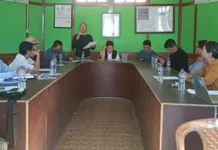[ Prof Ujjwal K Chowdhury ]
The general elections are just around the corner. Manifestos or not, the narratives in public meets and through the media are there for all to see.
Let’s first take the party and alliance in power. There are four pillars to the BJP/NDA narrative. First, there is the pitch for a visibly strong nation high on nationalism and proactive military action, as illustrated through the Balakot strike within Pakistan post the Pulwama massacre, and then this reiterated through Mission Shakti recently.
On 27 March, India conducted Mission Shakti, an anti-satellite missile test, from the Dr APJ Abdul Kalam Island launch complex. This was a technological mission carried out by the DRDO. The satellite used in the mission was one of India’s existing satellites operating in lower orbit. The test was fully successful and achieved all parameters as per plans. The test required an extremely high degree of precision and technical capability. The significance of the test is that India has tested and successfully demonstrated its capability to interdict and intercept a satellite in outer space, based on complete indigenous technology.
With this test, India joins an exclusive group of space-faring nations consisting of the USA, Russia and China.
Second, there is the pitch for a stable government led by a strong-willed leader, Narendra Modi, and his version of the BJP, ably assisted by party president Amit Shah. This underplays the fact that the BJP is leading among the 24 parties in the National Democratic Alliance (NDA), that there are a few more strong BJP leaders like Nitin Gadkari and Rajnath Singh with mass bases, and there have been a litany of conflicts, major and minor, with alliance partners, leading to the Shiv Sena, Paswan’s LJP and Nitish Kumar’s JD(U) being accommodated with a long rope. Alliance partners are temporarily fine as they expect that a Modi-driven, almost presidential, type of campaign will reap rich benefits.
Third, there is an unmistakable tilt towards using the communal lingo in the polls with every passing day. The way the Hindu-Muslim rhetoric is being used by the Modi himself with reference to the alleged miscarriage of justice vis-à-vis the Samjhauta blast, and about the strong Muslim electorate in Wayanad which Congress president Rahul Gandhi has picked up as his second seat, it is obvious the ferocity of the communal card shall be more aggressive down the line, as is seen in the speeches of UP CM Adityanath.
Fourth, the BJP leadership is harping on the dynastic roots of Rahul Gandhi and several other regional political leaders of other opposition parties, and saying that the opposition alliances are all opportunistic and weak.
And, interestingly, there is a fifth narrative, and it is a narrative in absentia. There is virtually no discourse on the very things based on which Modi ascended to power in 2014 or has highlighted while in power: no talks on corruption at high-places, black money from abroad, double digit GDP growth, benefits of demonetization, digital or start-up India missions, Namami Gangey, bullet train, Beti Padhao Beti Bachao, multi-layered GST, et al.
Now, let us look at the main opposition to the government.
After bumbling on opposition alliances in Delhi, Haryana, Andhra, Bengal and Telengana, being left out of the UP, etc, the Congress is now settling down with alliances in Bihar, Maharashtra, Jharkhand and Tamil Nadu in place. But this is surely a month late. With initial right noises of a mahagathbandhan, the Congress seems to have got the success in MP, Chhattisgarh and Rajasthan a bit too much into the head. The hurt of being left out of the UP battle has led them to put their two best faces, Priyanka Gandhi and Jyotiraditya Scindia, to sweat it out in the sweltering summer heat and dust of Uttar Pradesh. And even friends wonder why they are not best used in MP, CG, Rajasthan, et al.
Having apparently fumbled thus, the Congress narrative is picking up steadily now with the promise of its mindboggling NYAY scheme (Nyuntom Aye Yojana) in which, if voted to power, it promises to ensure a minimum income of Rs 12,000 a month for the poorest 5 crore families (20 crore people), incurring an expense of Rs 3.6 lakh crore a year, which is slightly above 10% of the GDP, thereby ensuring the universal concept of basic minimum income in India, along with all other welfare measures like MNREGA, NRHM, etc, and this covers rural, urban and tribal poor.
This surely has brought back the narrative on their side, along with the promise of directly elected mayors across India to ensure better urban governance and people’s control over the same.
And, ahead of the BJP, the Congress has now come out with their manifesto too. Apart from NYAY, the promises in the manifesto include commitment to legislate women’s reservation bill and reserve one-third of all government jobs for women; double education outlay at every level; free and compulsory school education up to Class 12 in public education; review of the AFSPA; omitting Section 124 A of the IPC that is known as the sedition law; filling up around 30 lakh jobs at various levels of the government; creating a separate kisan budget; legislating the Right to Healthcare Act; GST 2.0 with a single moderate tax rate; implementing the Forests Rights Act for tribal welfare in letter and spirit; abolishing opaque electoral bonds; stringency against hate crimes; establishing an environment protection authority; enacting the right to homestead act for the rural homeless, etc.
With this, the Congress has surely moved ahead with an ‘inclusive development’ campaign narrative. It, however, remains to be seen how far its candidates and cadres can take these promises, music to every Indian ear, down to the grassroots.
And the contrasting narratives of both the parties show some positives, in spite of the communal undertones in the ongoing campaign.
While the BJP scores heavily on the national pride and power front, the Congress scores on specific aspects of inclusive justice, especially through its NYAY scheme.
The Congress will be forced to talk about handling cross-border terror, its possible outlook towards Kashmiri militancy in today’s context, and sprucing up the military arsenal of the nation. It has already got a dossier on national security prepared by the army officer who led the post-Uri surgical strikes, Lt Gen DS Hooda, and has promised in the manifesto to upgrade defence budget and military modernization.
On the other hand, unabated communal rhetoric may not pay the desired dividends to the BJP, and the revival of the Ram Janmabhoomi movement did not meet with much enthusiasm from the people in spite of a well-organized Kumbh Mela to launch the same. And the Congress’ approach will require the rulers of the day to turn to more development-focused narrative, especially with regard to jobs, basic income, women’s issues, health and education, among other things. That surely is good for the nation.
As electioneering goes ahead, it is also expected that a rethinking on the role, independence and neutrality of the Election Commission and the media, apart from the fundamental premises of the constitution, shall emerge. And that to my mind is another good outcome of this largest festival of democracy in the world: the Indian general elections, along with the assembly polls in several states. (The contributor is Dean of School of Media, Pearl Academy.)




